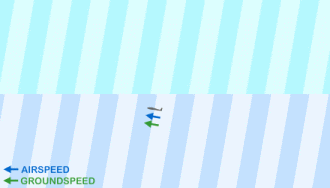Dynamic soaring
Dynamic soaring is a flying technique used to gain energy by repeatedly crossing the boundary between air masses of significantly different velocity. Such zones of high wind gradient are generally found close to obstacles and close to the surface, so the technique is mainly of use to birds and operators of radio-controlled gliders, but glider pilots have occasionally been able to soar dynamically in meteorological wind shears at higher altitudes. The highest speed reported by a radio-controlled glider is 519 mph (835 km/h).
Dynamic soaring is sometimes confused with controllable slope soaring which uses a similar but different technique for achieving elevation.
While different flight patterns can be employed in dynamic soaring, the simplest example to explain the energy extraction mechanism is a closed loop across the boundary layer between two airmasses in relative movement. The gain in speed can be explained in terms of airspeed or groundspeed:
The energy is extracted by reducing the velocity difference between the two airmasses during the 180° turns which accelerate air in opposite directions.
The following animation is a simplification of what actually happens. In practice, there is a turbulent mixing layer between the moving and stationary air masses. In addition, drag forces are continually slowing the plane once it has crossed the shear layer, so the airspeed gained by crossing the boundary is not all retained through the 180° turns. Higher speed gives rise to higher drag forces, so there is a maximum speed that can be attained, typically around 10 times the windspeed for efficient glider designs.
When seabirds perform dynamic soaring, the wind gradients are much less pronounced, so the energy extraction is comparably smaller. And instead of doing circles as glider pilots do, the birds will execute a series of half circles in opposite directions. For instance, a bird may begin by climbing though the gradient while facing into the increasing wind to gain airspeed, and then make a 180° turn (say) clockwise. This would be followed by a dive back down through the gradient, again increasing its airspeed as it moves into slower air at lower altitude. The cycle would then be completed by making an anti-clockwise turn at low altitude to face back into the wind. This has the effect of transporting the bird laterally to the wind, so it can travel cross wind indefinitely by continuing to execute this maneuver.
...
Wikipedia

